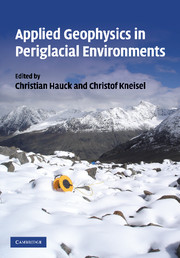Book contents
- Frontmatter
- Contents
- List of contributors
- Introduction
- Part I Geophysical methods
- Part II Case studies
- 5 Typology of vertical electrical soundings for permafrost/ground ice investigation in the forefields of small alpine glaciers
- 6 ERT imaging for frozen ground detection
- 7 Electrical resistivity values of frozen soil from VES and TEM field observations and laboratory experiments
- 8 Results of geophysical surveys on Kasprowy Wierch, the Tatra Mountains, Poland
- 9 Reassessment of DC resistivity in rock glaciers by comparing with P-wave velocity: a case study in the Swiss Alps
- 10 Quantifying the ice content in low-altitude scree slopes using geophysical methods
- 11 The use of GPR in determining talus thickness and talus structure
- 12 GPR soundings of rock glaciers on Svalbard
- 13 Arctic glaciers and ground-penetrating radar. Case study: Stagnation Glacier, Bylot Island, Canada
- 14 Mapping of subglacial topography using GPR for determining subglacial hydraulic conditions
- 15 Snow measurements using GPR: example from Amundsenisen, Svalbard
- 16 Mapping frazil ice conditions in rivers using ground penetrating radar
- Appendix: Tables of geophysical parameters for periglacial environments
- Index
- Plate section
- References
5 - Typology of vertical electrical soundings for permafrost/ground ice investigation in the forefields of small alpine glaciers
Published online by Cambridge University Press: 22 August 2009
- Frontmatter
- Contents
- List of contributors
- Introduction
- Part I Geophysical methods
- Part II Case studies
- 5 Typology of vertical electrical soundings for permafrost/ground ice investigation in the forefields of small alpine glaciers
- 6 ERT imaging for frozen ground detection
- 7 Electrical resistivity values of frozen soil from VES and TEM field observations and laboratory experiments
- 8 Results of geophysical surveys on Kasprowy Wierch, the Tatra Mountains, Poland
- 9 Reassessment of DC resistivity in rock glaciers by comparing with P-wave velocity: a case study in the Swiss Alps
- 10 Quantifying the ice content in low-altitude scree slopes using geophysical methods
- 11 The use of GPR in determining talus thickness and talus structure
- 12 GPR soundings of rock glaciers on Svalbard
- 13 Arctic glaciers and ground-penetrating radar. Case study: Stagnation Glacier, Bylot Island, Canada
- 14 Mapping of subglacial topography using GPR for determining subglacial hydraulic conditions
- 15 Snow measurements using GPR: example from Amundsenisen, Svalbard
- 16 Mapping frazil ice conditions in rivers using ground penetrating radar
- Appendix: Tables of geophysical parameters for periglacial environments
- Index
- Plate section
- References
Summary
Introduction
During the Little Ice Age (LIA), many small glaciers – usually less than 1 km wide and some having completely vanished since that time – overlaid permafrost areas in the Alps above approximately 2500 m a.s.l. Strong mechanical (e.g. push moraines) and thermal disturbances (e.g. permafrost degradation) of the former frozen sediments occurred. LIA glacier forefields located in the discontinuous belt of permafrost are thus complex geomorphic features (Figure 5.1) including various types of ground ice and coalescent frozen and unfrozen ground conditions (Evin and Assier1983). Since the 1980s, several studies have been carried out to map the ground ice distribution in such recently deglaciated terrains (e.g. Evin 1992, Kneisel 1999, 2003a). From the same perspective, we performed about 100 vertical electrical soundings (VES) on thirteen sites in the western Swiss Alps and the Pyrenees between 1997 and 2003 (Delaloye and Devaud 2000, Delaloye et al. 2003a,b, Reynard et al. 2003, Delaloye 2004, Lambiel et al. 2004, Lugon et al. 2004, Lambiel 2006). The following case study proposes an interpretative typology of VES measured in this kind of glacial/periglacial environment. The typology is complemented by additional indications on the ground surface thermal regime.
Method
The VES technique (see Chapter 1) is logistically adapted to permafrost investigations in difficult terrain and remote areas. The power supply requirement is limited and, in contrast to the ERT method, the basic equipment remains lightweight (and not expensive!).
Information
- Type
- Chapter
- Information
- Applied Geophysics in Periglacial Environments , pp. 101 - 108Publisher: Cambridge University PressPrint publication year: 2008
References
Accessibility standard: Unknown
- 1
- Cited by
